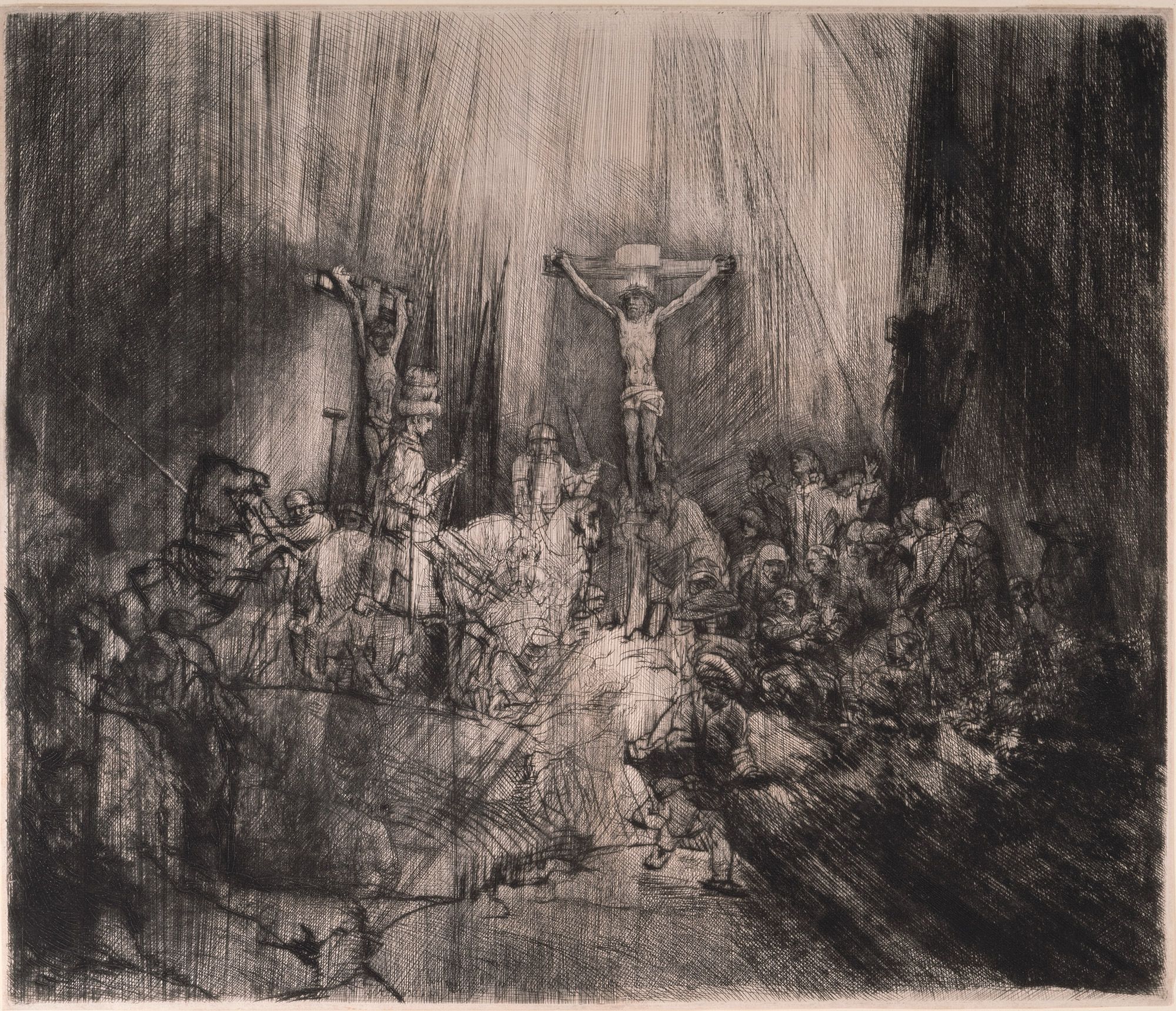FJK 108
Rembrandt (Harmensz Van Rijn) (Dutch, Leiden 1606–1669 Amsterdam)
The Three Crosses
1653
15 15/64 × 17 29/32 in. (387 × 455 mm)
Medium
Engraving and dry point
Watermark: Strasburg Lily in a shield with initials: “4” WR and countermark IHS (Ash & Fletcher 36A, initial “4” Wra)
Origin
Delteil. his sale, March 15, 1922 (£ 220)
P. & D. Colnaghi, London (stock number on the back)
Glihofer Collection, November 1, 1927 (£ 290)
Ruth C. Mailand Collection
Kimbell Art Foundation, Forth Worth, Texas, Acc. no. AP 79.31 (until May 1987)
Frederick Mulder Collection, London
Jan Krugier Collection, Monaco (acquired from previous owner in November 2003), JK 6179
Jan Krugier Foundation
Bibliography
The Illustrated Bartsch, New York: Abaris Press, 1978.
HIND Arthur Mayger,A catalogue of Rembrandt’s Etchings: chronologically arranged and completely illustrated, New York: Da Capo Press, 1967, no. 270.
Hollstein’s Dutch & Flemis etchings, engravings and woodcuts ca. 1450-1700, vol. XVIII-XIX, Rembrandt van Rijn, Amsterdam, 1969, no. 78.
MÜNZ Ludwig, Rembrandt’s Etchings, London: Phaidon, 1952, no. 223.
NOWELL-USTICKE G. W., Rembrandt’s Etchings: States and Values, Hacker Art Books, 1988, no. 78.
ROVINSKI Dmitri, L’œuvre gravé de Rembrandt, Catalogue raisonné, Saint Petersburg, Impr. de l’Académie impériale des Sciences, 1890-1894, no. 78.
WHITE Christopher, BOON Karen, Rembrandt’s Etchings, an Illustrated Critical Catalogue, Amsterdam: Van Gendt, 1970, 2 vol., no. 78.
Exhibitions
Munich, Hypo-Kulturstiftung,Das Ewige Auge - Von Rembrandt bis Picasso. Meisterwerke aus der Sammlung Jan Krugier und Marie-Anne Krugier-Poniatowski, 2007, p. 114, no. 49, color ill. p. 115.
Notes
Proof printed between the 4th and 5th and last states with the address of the publisher Carlese.
This engraving is one of the most important works in the history of this technique and was only matched in the twentieth century by Pablo Picasso.
The changes made by Rembrandt in the different states suggest that he was inspired by Saint Matthew: “About three in the afternoon Jesus cried out in a loud voice: My God, my God, why have you forsaken me?”
And for the last two states, perhaps more emotional and dramatic, by Saint Luke: “It was now about noon, and darkness came over the whole land until three in the afternoon, for the sun stopped shining. And the curtain of the temple was torn in two. Jesus called out with a loud voice, Father, into your hands I commit my spirit. When he had said this, he breathed his last. The centurion, seeing what had happened, praised God and said, Surely this was a righteous man. When all the people who had gathered to witness this sight saw what took place, they beat their breasts and went away.”
This entirely etched print is not only remarkable for its dimensions and its drama, but also for its simplicity. The changes made in the 4th state and the technical prowess of etching widely vary from one proof to another. Despite its fragility, Rembrandt had 90 proofs printed for each of the five states, exceeding the usual limit for etching. This shows the importance of this work as the cost for printing such a large etching must have been prohibitive.
With the present state, the viewer has the impression of a dark chaos as if the artist had chosen to set the scene in the darkness to add emotion and majesty as never before had they been reached. Rembrandt takes the biblical subject as if it was his own life. He adapts the scene to make it his own. The art work becomes The Theatre and Its Double by Antonin Artaud.
We also distinguish four characters: the rider of the Renaissance, likely inspired by a medal by Pisanello around 1440 and reinterpreted by Picasso in a small aquatint in 1970 (Bloch, 1879; Baer, 1884, II); Mary Magdalene in tears; the fainted Virgin; Saint John raising his arms and Pilate or the centurion in profile next to his horse.
Without any recourse to preparatory drawings, this extraordinary engraved vision stands as a unique and highly personal work.
Fax from Emmanuel Benador, November 2003 (translated from French)
Request for information/loan
The Jan Krugier Foundation is devoted to increasing the impact of the collection of drawings through regular loans to major exhibitions. Loan applications should include a complete presentation of the project.

